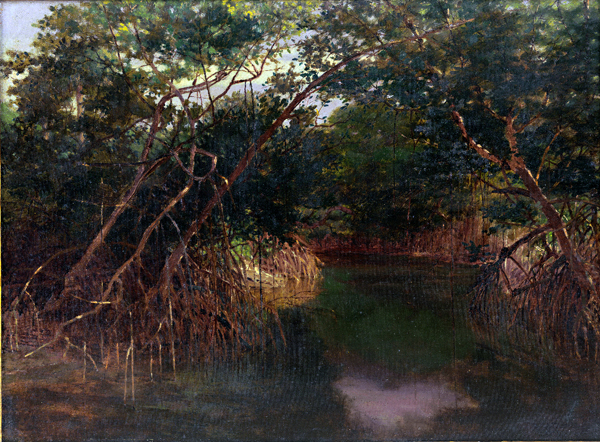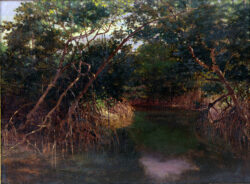Artists’ Association of New Orleans
The Artists' Association of New Orleans, which was incorporated in 1886, promoted the appreciation of fine arts in the South in general and New Orleans in particular.

Courtesy of Louisiana State Museum
Mangrove Swamp. Wilkstrom, Anders Bror (Artist)
Like its predecessor, the Southern Art Union, the Artists’ Association of New Orleans promoted the appreciation of fine arts in the South in general and New Orleans in particular. Members, including many of the city’s leading artists, established a school of art and held regular exhibitions. Largely successful in its endeavors, the association helped establish and develop a stable community of professional artists in late-nineteenth-century New Orleans.
Incorporated in 1886, the Artists’ Association of New Orleans was formed on the heels of the Southern Art Union, which had disintegrated because of organizational problems and conflicts among the members. Many of the same individuals, however, led both organizations. Artists Andres Molinary, William Henry Buck, Paul E. Poincy, Charles Wellington Boyle, Edward Livingston, and George David Coulon, for example, helped found both organizations. Molinary and Boyle were particularly active in the Artists’ Association throughout its history.
On October 3, 1885, the association opened its School of Art at the State National Bank Building, with about thirty students enrolled in classes. From its inception, some of the city’s most prominent artists agreed to teach without pay until the Artists’ Association was established enough to provide salaries. During the 1886–1887 academic year, George David Coulon and Charles Wellington Boyle taught elementary art classes, Bror Anders Wikström taught sketching, and Paul Poincy taught classes on perspective. August Nolte taught the night class. The course offerings later expanded to include oil painting, watercolor, and sculpting and modeling, the latter was taught by Achille Perelli.
In December 1885, the association held its first art exhibition. By the following October, it announced its first annual artists’ exhibition in the association’s headquarters at 31-33 Camp Street. Each member was required to contribute one artwork to the annual exhibition to defray the cost of equipment for the school. A copperplate etching by Bror Anders Wikström accompanied each invitation to the event. As the organization grew in strength, artists from other states showed their works in its exhibitions.
When the group outgrew its Camp Street headquarters, it moved to 59 Carondelet Street. On October 1, 1890, the association moved again, to 203 Camp Street, where the fifth annual exhibition opened on December 16. In later years the association exhibited at the Fisk Library. The association also sponsored a periodical called Art and Letters, which was published bimonthly in 1887. The first issue appeared in February and the last in December, after which it ceased publication.
By the late 1890s, additional organizations for the promotion of art had developed and, as a result, support for the Artists’ Association diminished. Eventually, the association decided to merge with the Arts Exhibition Club to form the Art Association of New Orleans. On December 10, 1903, members of the new organization met at the Athenaeum to elect officers, thereby finalizing the termination of the Artists’ Association.
